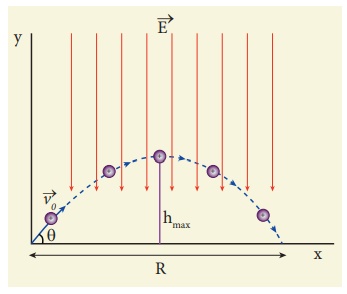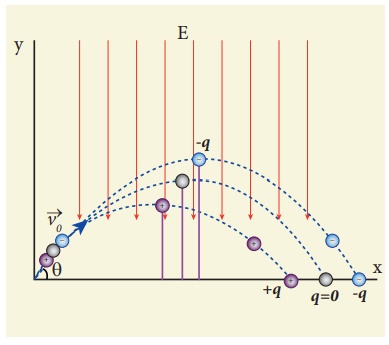Electrostatics of Conductors and Dielectrics - Electrostatic induction | 12th Physics : Electrostatics
Chapter: 12th Physics : Electrostatics
Electrostatic induction
Electrostatic induction
In section 1.1, we have
learnt that an object can be charged by rubbing using an appropriate material.
Whenever a charged rod is touched by another conductor, charges start to flow
from charged rod to the conductor. Is it possible to charge a conductor without
any contact? The answer is yes. This type of charging without actual contact
is called electrostatic induction.
(i) Consider an
uncharged (neutral) conducting sphere at rest on an insulating stand. Suppose a
negatively charged rod is brought near the conductor without touching it, as
shown in Figure 1.49(a).

The negative charge of
the rod repels the electrons in the conductor to the opposite side. As a
result, positive charges are induced near the region of the charged rod while
negative charges on the farther side.![]()
![]()
Before introducing the
charged rod, the free electrons were distributed uniformly on the surface of
the conductor and the net charge is zero. Once the charged rod is brought near
the conductor, the distribution is no longer uniform with more electrons
located on the farther side of the rod and positive charges are located closer
to the rod. But the total charge is zero.
(ii) Now the conducting
sphere is connected to the ground through a conducting wire. This is called
grounding. Since the ground can always receive any amount of electrons,
grounding removes the electron from the conducting sphere. Note that positive
charges will not flow to the ground because they are attracted by the negative
charges of the rod (Figure 1.49(b)).
(iii) When the grounding wire is removed from
the conductor, the positive charges remain near the charged rod (Figure
1.49(c))
(iv) Now the charged rod is taken
away from the conductor. As soon as the charged rod is removed, the positive
charge gets distributed uniformly on the surface of the conductor
(Figure 1.49 (d)). By this process, the neutral conducting sphere becomes
positively charged.
For an arbitrary shaped
conductor, the intermediate steps and conclusion are the same except the final
step. The distribution of positive charges is not uniform for
arbitrarily-shaped conductors. Why is it not uniform? The reason for it is
discussed in the section 1.9
EXAMPLE 1.19
A small ball of conducting
material having a charge +q and mass m is thrown upward at an angle θ to
horizontal surface with an initial speed vo as shown in the figure.
There exists an uniform electric field E downward along with the gravitational
field g. Calculate the range, maximum height and time of flight in the motion
of this charged ball. Neglect the effect of air and treat the ball as a point
mass.

Solution
If the conductor has no
net charge, then its motion is the same as usual projectile motion of a mass m
which we studied in Kinematics (unit 2, vol-1 XI physics). Here, in this
problem, in addition to downward gravitational force, the charge also will
experience a downward uniform electrostatic force.
The acceleration of the
charged ball due to gravity = -g j ^
The acceleration of the
charged ball due to uniform electric field = -qE/m j ^
The total acceleration
of charged ball in downward direction

It is important here to note that
the acceleration depends on the mass of the object. Galileo’s conclusion that
all objects fall at the same rate towards the Earth is true only in a uniform
gravitational field. When a uniform electric field is included, the
acceleration of a charged object depends on both mass and charge.
But still the acceleration a = ( g +
qE/ m ) is constant throughout the
motion. Hence we use kinematic equations to calculate the range, maximum height
and time of flight.
In fact we can simply replace g by g
+ qE/m in the usual expressions of
range, maximum height and time of flight of a projectile.

Note that the time of flight,
maximum height, range are all inversely proportional to the acceleration of the
object. Since ( g + qE/m ) > g for
charge +q, the quantities T, hmax, and R will decrease when compared
to the motion of an object of mass m and zero net charge. Suppose the charge is
–q, then ( g - qE/m ) < g , and the
quantities T, hmax and R will increase. Interestingly the trajectory is still
parabolic as shown in the figure.

Related Topics